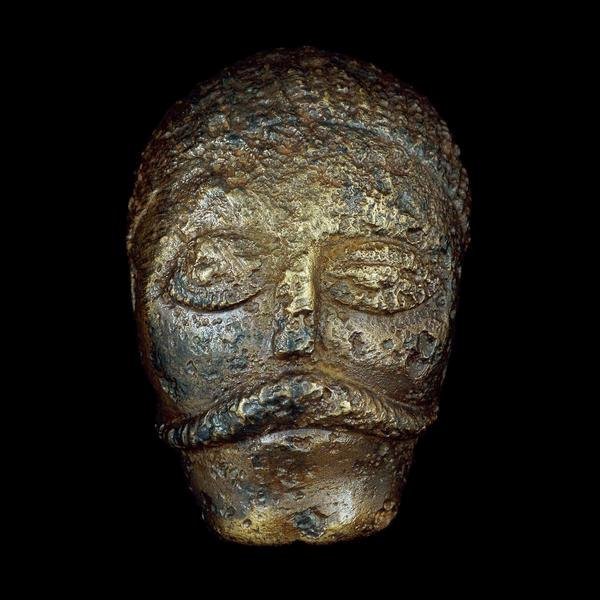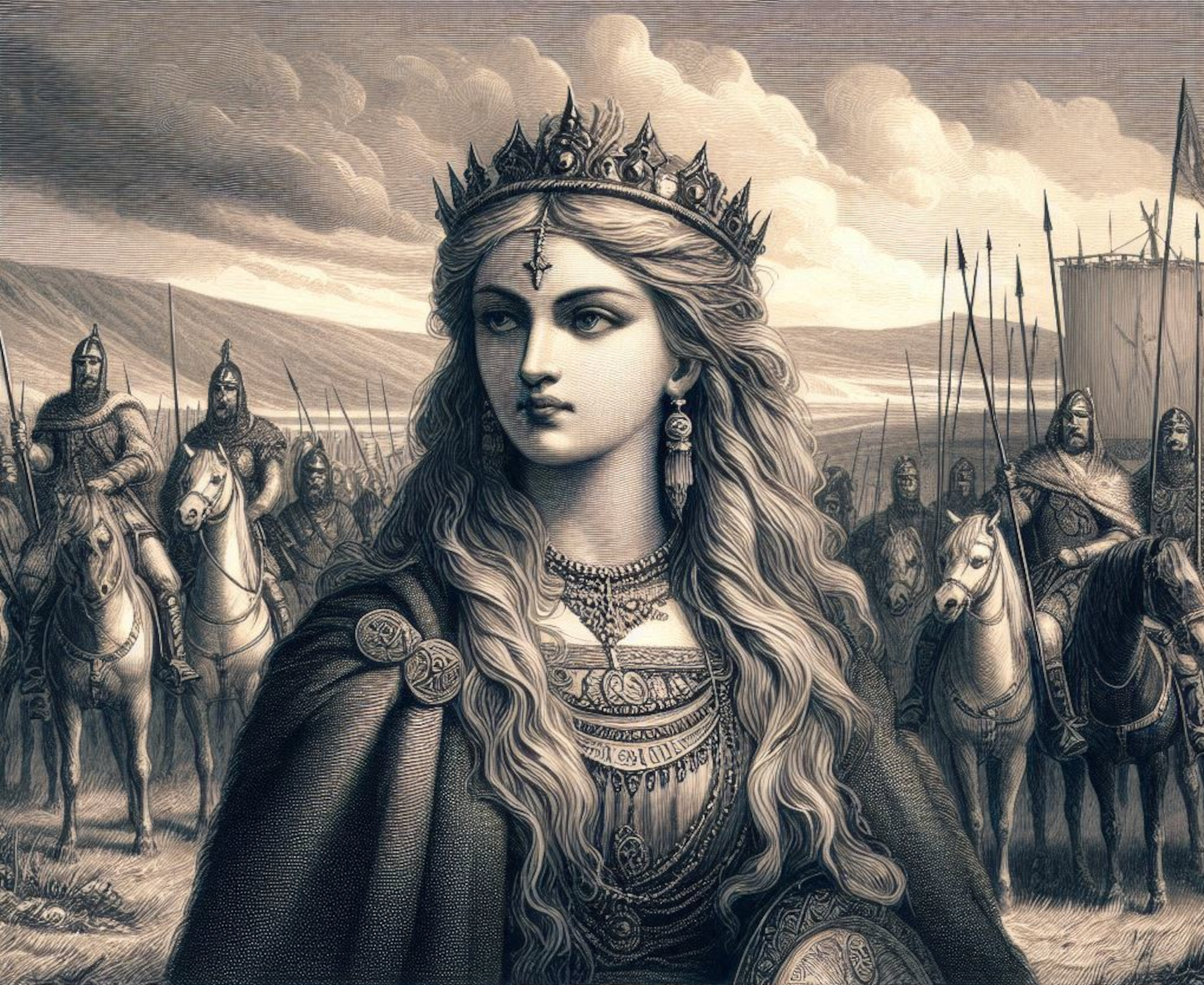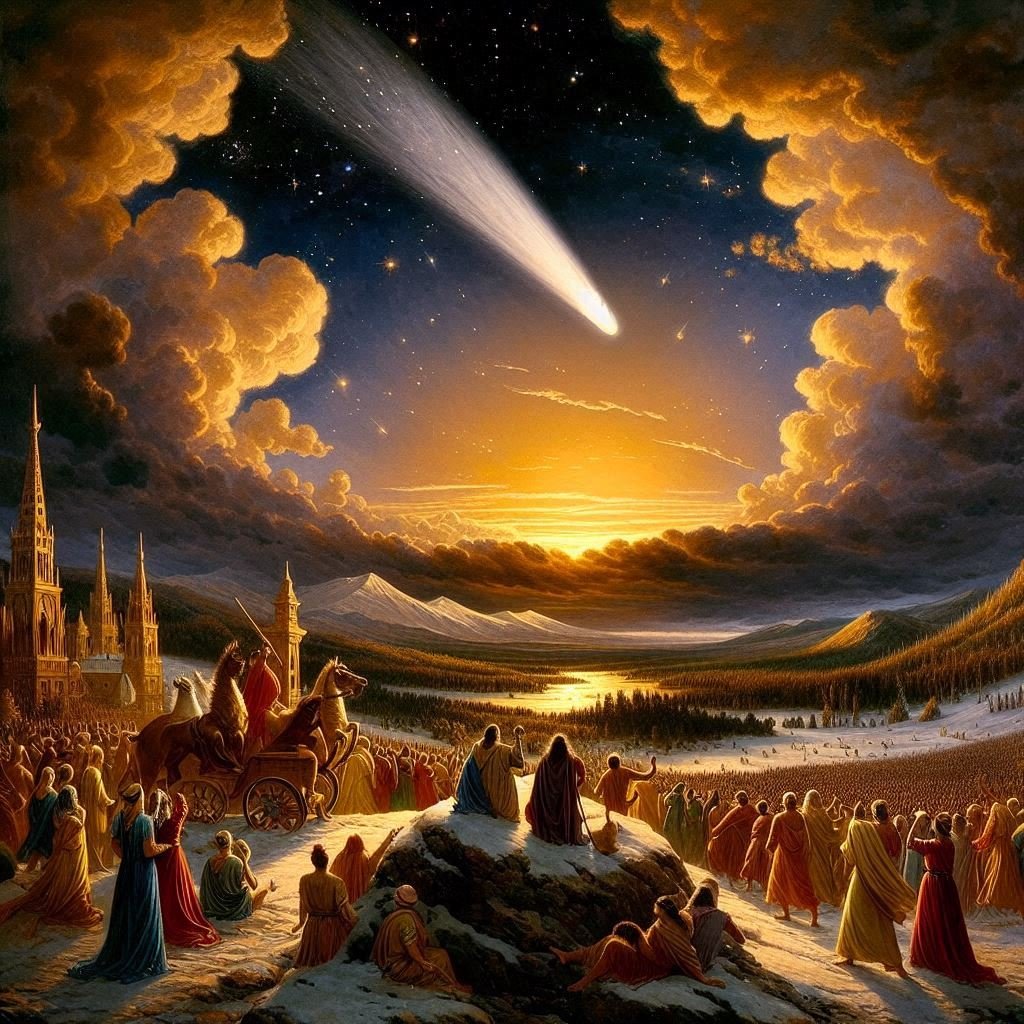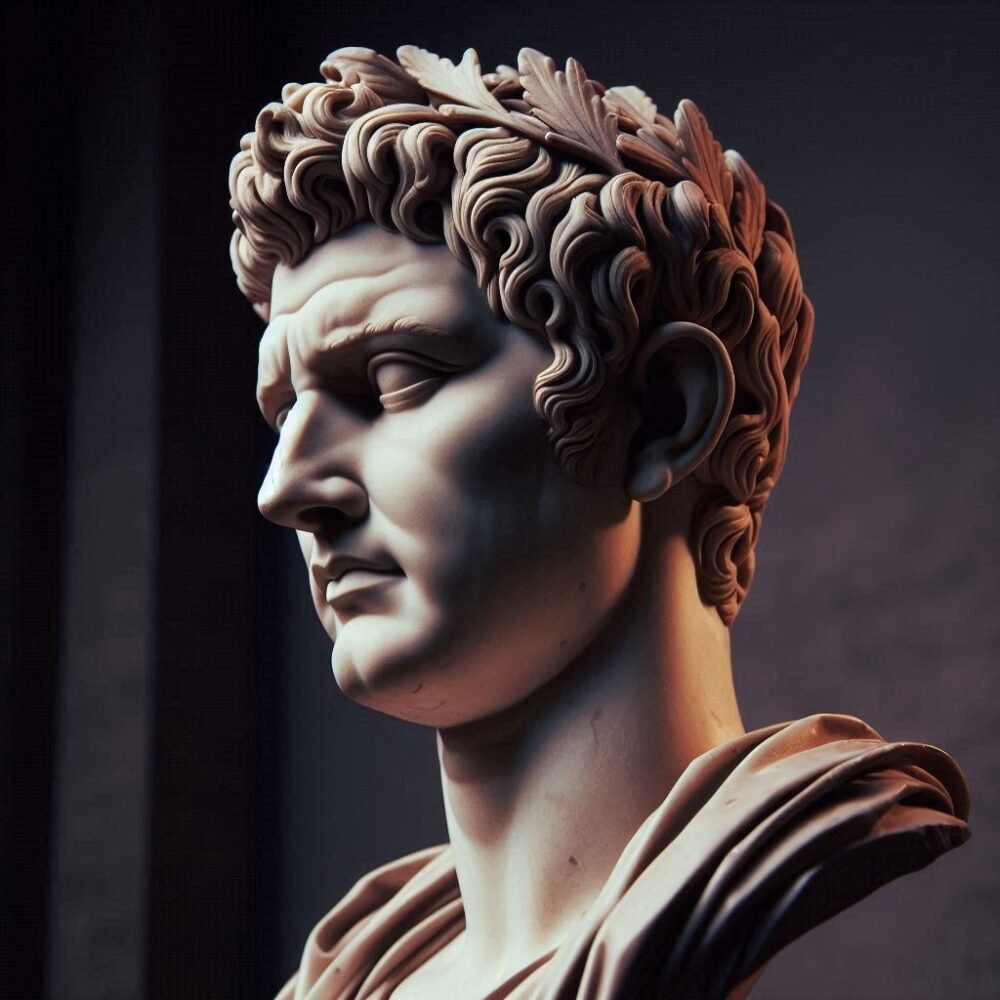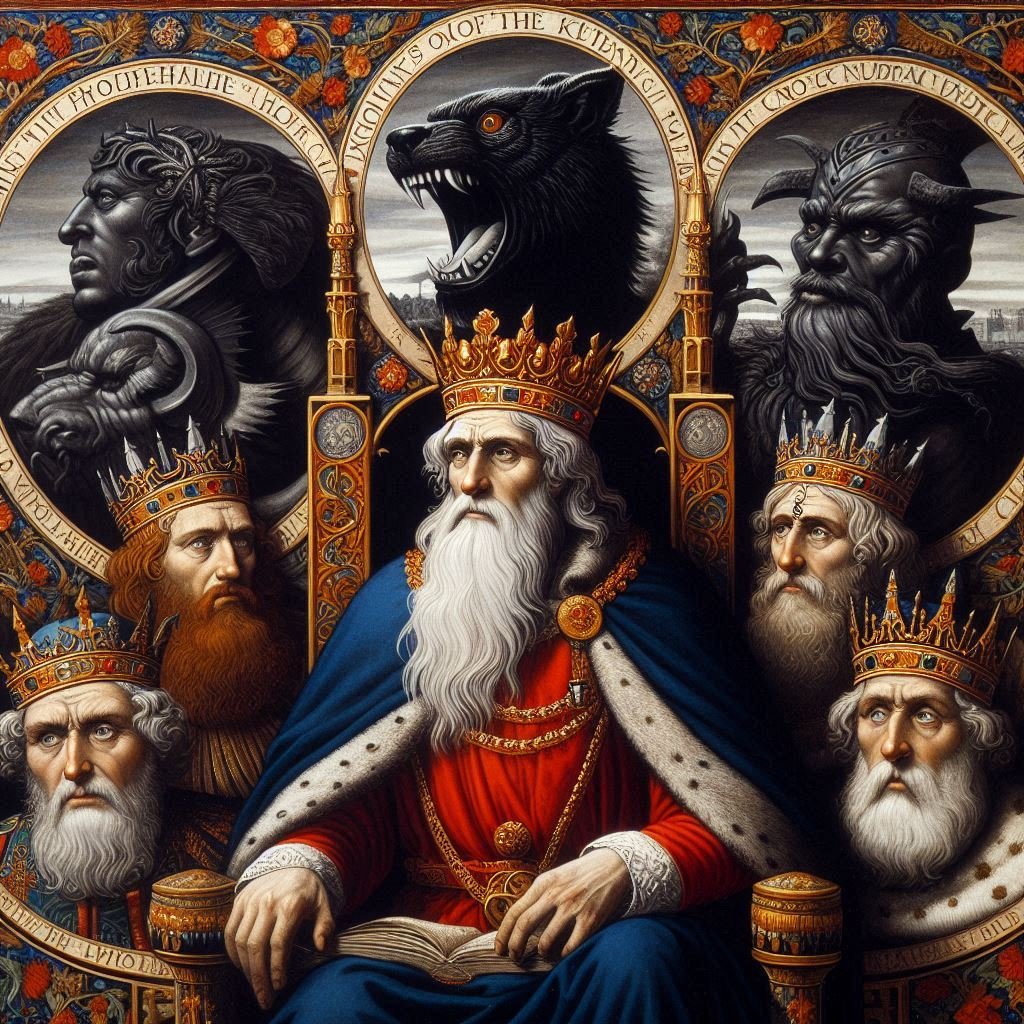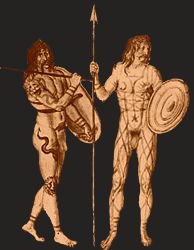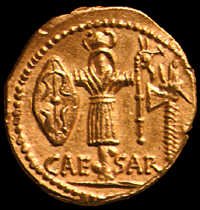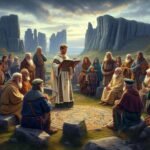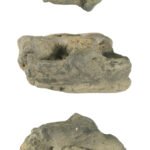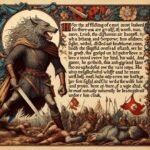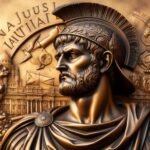Drawings of Celtic warriors as envisioned by Lucas de Heere, 1575
Though these may seem fairly accurate, more recent interpretations of how Celtic warriors looked in the late La Tène or Iron Age period before the Claudian invasions in Gaul and Britain are available. This includes depictions on coins, primarily Roman, as well as evidence from buried artifacts.
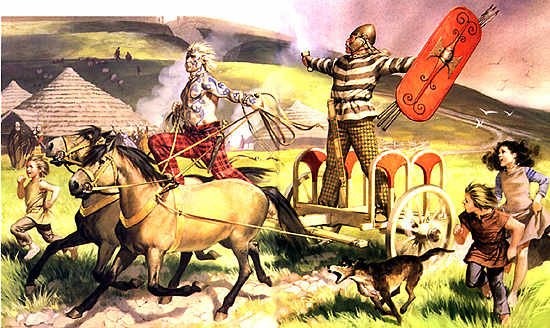
This image comes from an interesting book called Rome’s Enemies 2 Gallic and British Celts, #158 in the Men-At-Arms Series, by Peter Wilcox and Angus MacBride (ISBN: 0850456061), 1985. The paintings, done by McBride, are based on literary descriptions and archaeological finds and are said to be as accurate as possible at this time.
The Numismatics of Celtic Warriors
One of the earliest coins of the Roman Republic having a Celtic subject is a Denarius of M. Sergius Silus (116-115 BCE, Crawford 286)
The reverse alludes to his grandfather, a hero of the 2nd Punic war. Having lost his right arm in battle, he fashioned an iron arm and went on to defeat 12 enemy camps in Gaul. Note that both sword and head are held in his left hand. (Pliny)
A close up of the head shows it to be wearing a helmet similar to that on the warrior above and the coin below.
Celtic Charioteers: “In both journeys and battles, the Gauls use two-horse chariots which carry both the warrior and the charioteer.” [ Diodorus Suculus ] Since the Celts left few depictions of themselves, we are fortunate Roman coinage provides powerful images that generally confirm the written record. The 2 horse chariot (Roman ‘biga’) with six-spoked wheels seen on these 2 coins are identical to the few archaeological finds. Both coins depict a warrior, wielding a Celtic style shield and about to hurl a spear. The horses are bridled, and shown with powerful forward motion. Both warriors are naked and helmeted. The SCAURUS coin shows Bituitus, Chief of the Averni, with a spear and a typical Celtic war trumpet (carynx) with an animal shaped bell identical to those shown on the Gundestrup cauldron. L. Hostilius Saserna, denarius, (48 BCE, S312; Cr. 448/3)
Caesar, gold aureus, 48 BCE (HCRI 10)
Julius Caesar is probably best known to Celtic scholars for his description of the Gauls and Druids in his writings about the Gallic wars. This and the following two coins depict Gallic arms, trophies of war and were being used by Caesar to commemorate his victories in Gaul as well as downplaying the then current civil conflict with Pompey.
For our purposes the reverse is useful in showing us what Celtic arms looked like.
The shield is long, oval with rounded ends and is decorated.
The helmet is horned and has long ear and neck guards.
The war horn is of typical Celtic style, the bell being the head and open mouth of a fanciful animal.
The armor appears to be cloth which according to classical historians was brightly colored and patterned.
An axe is shown surmounted by a similar animal head. Though classical sources speak of spears, javelins and swords being used by Celtic warriors, the large numbers of axe heads found in Celtic territories and grave sites suggest they were almost certainly used as weapons. Caesar may have choose the axe to show since it was one of the symbols of the pontificate, and alludes to Caesar as Pontifex Maximus.
Caesar, silver denarius, 48 BCE (HCRI 11)
 Caesar denarius, military mint in Spain, late 46 to early 45 BCE (HCRI 59)
Caesar denarius, military mint in Spain, late 46 to early 45 BCE (HCRI 59)
For several years Caesar had been chasing Pompey’s forces around the Mediterranean with final victory in Spain. The reverses of the coins minted to pay for this campaign again celebrate his Gallic victories– propaganda for war-weary Romans. Again we see typical Gallic arms: two shields, 2 spears., an animal headed war-horn, a torque and a horned helmet. Looking closely at the battle dress, it appears to be chain or scale mail, rare among the Celts who, it is said, invented chain mail, though the torque suggests these are the Chieftain’s arms. The ‘apron’ is also decorated, perhaps studded leather or metal repoussé.
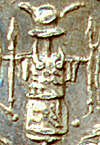
Below are 2 Gallic captives, a dejected female wearing a draped gown and a kneeling male with his hands tied behind. His pointed beard is similar to that on the next coin.
 L. Hostilius Saserna, silver denarius, Rome 48 BCE (HCRI 18)
L. Hostilius Saserna, silver denarius, Rome 48 BCE (HCRI 18)
Rarely do we see portraits of actual Celts, and when done are usually idealized statuary. The following 2 coins were minted by the moneyer L. Hostilius Saserna probably under the aegis of Caesar and not the Senate.
The appearance of this portrait is much different than those of Romans, enhancing their ‘barbarian’ or foreign nature to Roman citizens. The hair is long and most likely limed, the beard and moustaches prominent and the facies peculiar. A Celtic shield is behind, and he wears a chain around his neck. This Roman has often been called Vercingetorix, most likely a Romantic notion, but then, who really knows. The reverse of this coin is the shown above.
L. Hostilius Saserna, silver denarius, Rome 48 BCE (HCRI 19)
 The sister coin to the above shows a female Gaul with a typical Celtic carynx behind. She has often been called Gallia, a concept that would be absolutely foreign to the tribal Celts. More likely she represents a captive. Hear hair is long in a non-Roman fashion and almost modern in appearance, perhaps limed and forming dreadlocks. Her face is pretty in contrast to most Roman females depicted on coins.
The sister coin to the above shows a female Gaul with a typical Celtic carynx behind. She has often been called Gallia, a concept that would be absolutely foreign to the tribal Celts. More likely she represents a captive. Hear hair is long in a non-Roman fashion and almost modern in appearance, perhaps limed and forming dreadlocks. Her face is pretty in contrast to most Roman females depicted on coins.
It has been suggested that the reverse of this coin, which depicts Artemis in a Greek fashion, commemorates Caesar’s taking of Massilia which interfered with his march to Spain. Massila was an ancient Greek city and Artemis dear to her.
HCRI: Sear, DR: The History and Coinage of the Roman Imperators 49-27 BC, Spink, London, 1998, ISBN: 0907605982


